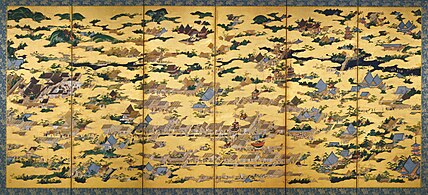
Kyoto
Kyoto (/ˈkjoʊtoʊ/;[3] Japanese: 京都, Kyōto [kʲoꜜːto] ⓘ), officially Kyoto City (京都市, Kyōto-shi, [kʲoːtoꜜɕi] ⓘ), is the capital city of Kyoto Prefecture in the Kansai region of Japan's largest and most populous island of Honshu. As of 2020, the city had a population of 1.46 million, making it the ninth-most populous city in Japan. The city is the cultural anchor of the substantially larger Greater Kyoto, a metropolitan statistical area (MSA) home to a census-estimated 3.8 million people. It is also part of the even larger Keihanshin metropolitan area, along with Osaka and Kobe.
This article is about the city in Japan. For the prefecture where the city is located, see Kyoto Prefecture. For other uses, see Kyoto (disambiguation).
Kyoto
京都市
794
Kyoto City Assembly
827.83 km2 (319.63 sq mi)
971 m (3,186 ft)
9 m (30 ft)
1,463,723
1,800/km2 (4,600/sq mi)
3,783,014
京都
きょうと
キョウト
Kyōto
Kyōto
Kyouto
Kyoto is one of the oldest municipalities in Japan, having been chosen in 794 as the new seat of Japan's imperial court by Emperor Kanmu. The original city, named Heian-kyō, was arranged in accordance with traditional Chinese feng shui following the model of the ancient Chinese capitals of Chang'an and Luoyang. The emperors of Japan ruled from Kyoto in the following eleven centuries until 1869. It was the scene of several key events of the Muromachi period, Sengoku period, and the Boshin War, such as the Ōnin War, the Honnō-ji Incident, the Kinmon incident, and the Battle of Toba–Fushimi. The capital was relocated from Kyoto to Tokyo after the Meiji Restoration. The modern municipality of Kyoto was established in 1889. The city was spared from large-scale destruction during World War II and, as a result, its prewar cultural heritage has mostly been preserved.
Kyoto is considered the cultural capital of Japan and is a major tourist destination. The agency for cultural affairs of the national government is headquartered in the city. It is home to numerous Buddhist temples, Shinto shrines, palaces and gardens, some of which have been designated collectively as a World Heritage Site by UNESCO. Prominent landmarks include the Kyoto Imperial Palace, Kiyomizu-dera, Kinkaku-ji, Ginkaku-ji, and Kyoto Tower. The internationally renowned video game company Nintendo is based in Kyoto. Kyoto is also a center of higher learning in the country, and its institutions include Kyoto University, the second-oldest university in Japan.
Name[edit]
In Japanese, Kyoto was previously called Kyō (京), Miyako (都), Kyō no Miyako (京の都), and Keishi (京師). After becoming the capital of Japan at the start of the Heian period (794–1185), the city was often referred to as Heian-kyō (平安京, "Heian capital"), and late in the Heian period the city came to be widely referred to simply as "Kyōto" (京都, "capital city"). After the seat of the emperor was moved to the city of Edo and that city was renamed "Tōkyō" (東京, meaning "eastern capital"), Kyoto was briefly known as "Saikyō" (西京, meaning "western capital"). As the capital of Japan from 794 to 1868, Kyoto is sometimes called the thousand-year capital (千年の都).
Historically, foreign spellings for the city's name have included Kioto and Miaco or Meaco.[4][5]
Geography[edit]
Terrain[edit]
Kyoto is located in a valley, part of the Yamashiro (or Kyoto) Basin, in the eastern part of the mountainous region known as the Tamba highlands. The Yamashiro Basin is surrounded on three sides by mountains known as Higashiyama, Kitayama and Nishiyama, with a maximum height of approximately 1,000 meters (3,281 ft) above sea level. This interior positioning results in hot summers and cold winters. There are three rivers in the basin, the Uji River to the south, the Katsura River to the west, and the Kamo River to the east. Kyoto City takes up 17.9% of the land in Kyoto Prefecture and has a total area of 827.9 square kilometers (319.7 sq mi).
Kyoto sits atop a large natural water table that provides the city with ample freshwater wells. Due to large-scale urbanization, the amount of rain draining into the table is dwindling and wells across the area are drying at an increasing rate.
Climate[edit]
Kyoto has a humid subtropical climate (Köppen Cfa), featuring a marked seasonal variation in temperature and precipitation. Summers are hot and humid, but winters are relatively cold with occasional snowfall. Kyoto's rainy season begins around the middle of June and lasts until the end of July, yielding to a hot and sunny latter half of the summer. Kyoto, like most of the Pacific coast and central areas of Japan, is prone to typhoons during the summer and autumn.
Cityscape[edit]
Kyoto contains roughly 2,000 temples and shrines.[17] The main business district is located to the south of the Kyoto Imperial Palace. In the center of the city, there are several covered shopping arcades only open to pedestrian traffic, such as Teramachi Street and Shinkyōgoku Street.
The original city was arranged in accordance with traditional Chinese feng shui following the model of the ancient Chinese capital of Chang'an/Luoyang. The Imperial Palace faced south, resulting in Ukyō (the right sector of the capital) being on the west, while Sakyō (the left sector) is on the east. The streets in the modern-day wards of Kamigyō-ku, Nakagyō-ku, and Shimogyō-ku still follow a grid pattern. Areas outside of the city center do not follow the same grid pattern, though streets throughout Kyoto are referred to by name, a practice that is rare in most regions of Japan.


